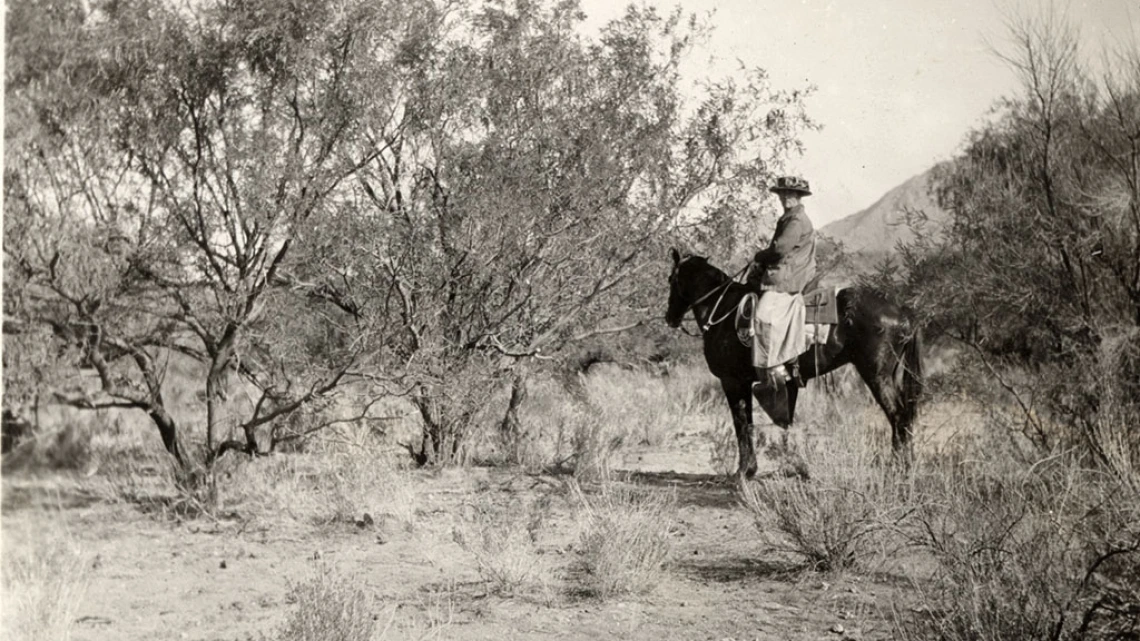Frances Douglas papers

Frances Douglas on horse in the Tucson desert, 1925.
Collection area: Borderlands
Collection dates: 1892-1963
The bulk of the papers relate to Frances Douglas' life after 1911. With the exception of photographs of family and friends prior to that date, there is little information about her early life; many of the photographs of Charles Lummis are unidentified, even when he is in pictures with others who are identified. Correspondence (Series II) with family and Douglas' diaries (in Series I) provide some information regarding her early life, but not very much. The diary from 1892-1893 documents many of her daily activities in California; many of the entries are in Spanish. There is a huge gap in the diaries represented here, with the next diary dated 1910, after Douglas' relocation to San Francisco. The diaries dated 1910, 1911, and 1912 mention little about her crumbling relationship with Lummis-although there are a few brief entries regarding notice of the separation in the papers-and, equally surprising is the lack of mention of Courtenay DeKalb, whose address is listed on one of her first copyright applications, in 1908. Additionally, the early correspondence with family is equally vague on this first part of her life, as if she wished to wipe parts of it from the record (her entry in
However, Douglas' correspondence files for the years following 1911 is a rich resource for those interested in her work and her relationships with authors and other leading scholars of the time. As Douglas maintained a copy of her outgoing correspondence, both sides of a conversation with an author, editor, or family member are well documented. Researchers will find of particular interest Douglas' correspondence with publishers and authors, most particularly her correspondence with Concha Espina, whom she tried diligently to introduce to the American public in the same way she did with Vincente Blasco Iba?? Espina's works were not as well received in America as they were in Spain, and the letters Douglas wrote to one publisher after another on behalf of the author (and her translations from the Spanish) document her unsuccessful crusade. Additionally interesting is the correspondence regarding the Roadside Mine, near Silverbell, Arizona co-owned by Douglas and DeKalb, as well as her additional mining claims.
In Series III Manuscripts are the drafts of much of her translations as well as copies of articles, short stories, and book reviews she submitted to newspapers and magazines. In some cases, Douglas retained the copy of the work she was translating from Spanish, as well as her notes and vocabulary lists. Of interest is the copy of the American edition of Blasco Ibanez's
Author and translator Frances Douglas was born into a large family on 19 November 1870 in Milford, Connecticut; her parents were Alanson Delos Douglas and Betsy Ellen Miller. Frances attended only a few years of grammar school, and when she was sixteen, she joined her older sister Ida in Isleta, New Mexico. She began studying Spanish soon thereafter, at one point claiming that she knew "so many people who knew a little of several languages and decided [she] wanted to know all [she] could about one". Most of her knowledge of the language was self-taught, acquired from reading and from constant conversation with the Mexicans and Native Americans living in the area.
In 1891, Frances met author and activist Charles Fletcher Lummis in Isleta. Lummis was in Isleta working on behalf of the Pueblo Indians who were resisting government education program; he was also hiding from San Mateo bosses he had angered with his articles, and who had a reward on his head. [The two fell in love and had their first child, Turbesé, out of wedlock, as Lummis' divorce was not yet final.] In 1892-in a rather peculiar arrangement-Frances and Turbesé went to live with Lummis' soon-to-be-ex-wife, Dorothea, in Los Angeles until the divorce went through. The couple had four children: Dorothea (Turbesé, Lummis Fiske (1892- ), Amado Lummis (1894-1900), Jordan (Quimu) Lummis (1899- ), and Keith Lummis (1904- ). The couple had a troubled marriage, and in June 1909, Frances fled with Keith and Turbesé to San Francisco. While in San Francisco, she began a close friendship with mining engineer Courtenay DeKalb, whom she had known at least since 1908. In 1911, Frances moved to Tucson and filed for divorce from Charles Lummis, citing physical and emotional abuse and philandering. She married Courtenay DeKalb in 1913.
Frances Douglas began writing and translating Spanish authors in 1909, and published her first translation, of Vincente Blasco Ibanez's
With Courtenay DeKalb, Frances visited Spain twice in 1918 and 1926, on behalf of the United States Commerce Department. During these visits, in addition to her work for the government, she visited authors, organizations, and publishers. She also spent time with Concha Espina, with whom she had become close. In 1933, the University of Arizona honored Frances Douglas with an honorary doctor of letters, and in 1935 Frances Douglas became a charter member of the American Association of University Women. Between 1930-1941, she was the Associate Editor of
Throughout the 1930s and 1940s, Frances continued to write and publish translations of her favorite authors, as well as short stories of her own. Additionally, she remained active giving speeches to various local and national women's and book clubs. In 1963, Frances Douglas and her daughter moved to San Diego, California. Prior to the move, she donated her library of 1100 books to the University of Arizona's Department of Romance Languages. Frances Douglas died in Berkeley, California in March 1969.
A collection guide explains what's in a collection. New to using our collections? Learn how to use a collection guide.
Collection guideAccess this collection
Visit us in person to access materials from this collection. Our materials are one-of-a-kind and require special care, so they can’t be checked out or taken home.
How to cite
Learn how to cite and use materials from Special Collections in your research.
